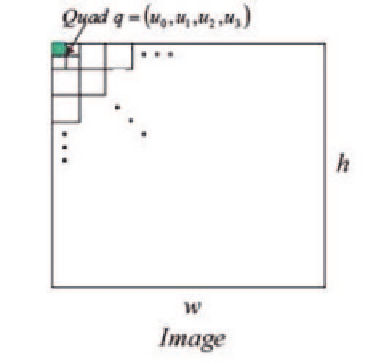Cryptography Reference
In-Depth Information
⎡
⎣
1
⎤
⎦
−(c−a
0
)
/
c
−(a
2
+ a
3
)
/
c
−
a
3
/
c
a
0
/
c
−(a
2
+ a
3
)
/
c
−
a
3
/
c
1
−1
D
=
.
(13.19)
a
0
/
c
(a
0
+ a
1
)
/
c
−
a
3
/
c
1
a
0
/
c
(a
0
+ a
1
)
/
c
(c−a
3
)
/
c
1
Fig. 13.8.
Quads configuration in an image.
Using the above theorem, for the vector q =(u
0
,u
1
,u
2
,u
3
), the appropri-
ate GRIT may be defined as:
⎧
⎨
a
0
u
0
+a
1
u
1
+a
2
u
2
+a
3
u
3
a
0
+a
1
+a
2
+a
3
⎩
v
0
=
,
v
1
= u
1
−u
0
,
(13.20)
v
2
= u
2
−u
1
,
v
3
= u
3
−u
2
.
⎧
⎨
(a
0
+a
1
+a
2
)v
1
+(a
2
+a
3
)v
2
+a
3
v
3
a
0
+a
1
+a
2
+a
3
⎩
u
0
= v
0
−
,
u
1
= v
1
+ u
0
,
u
2
= v
2
+ u
1
,
u
3
= v
3
+ u
2
.
(13.21)
To describe the reversible algorithm in detail and unambiguously, we
choose quads to introduce the embedding process and the detection process.
A quad is a 14 vector formed from four pixel values chosen from four differ-
ent locations each having the same component according to a predetermined
order. Each quad is assembled from 22 adjacent pixel values in Alatters
algorithm (Fig. 13.8). Each pixel quad of the original image is classified into
three groups according to the following definitions.



